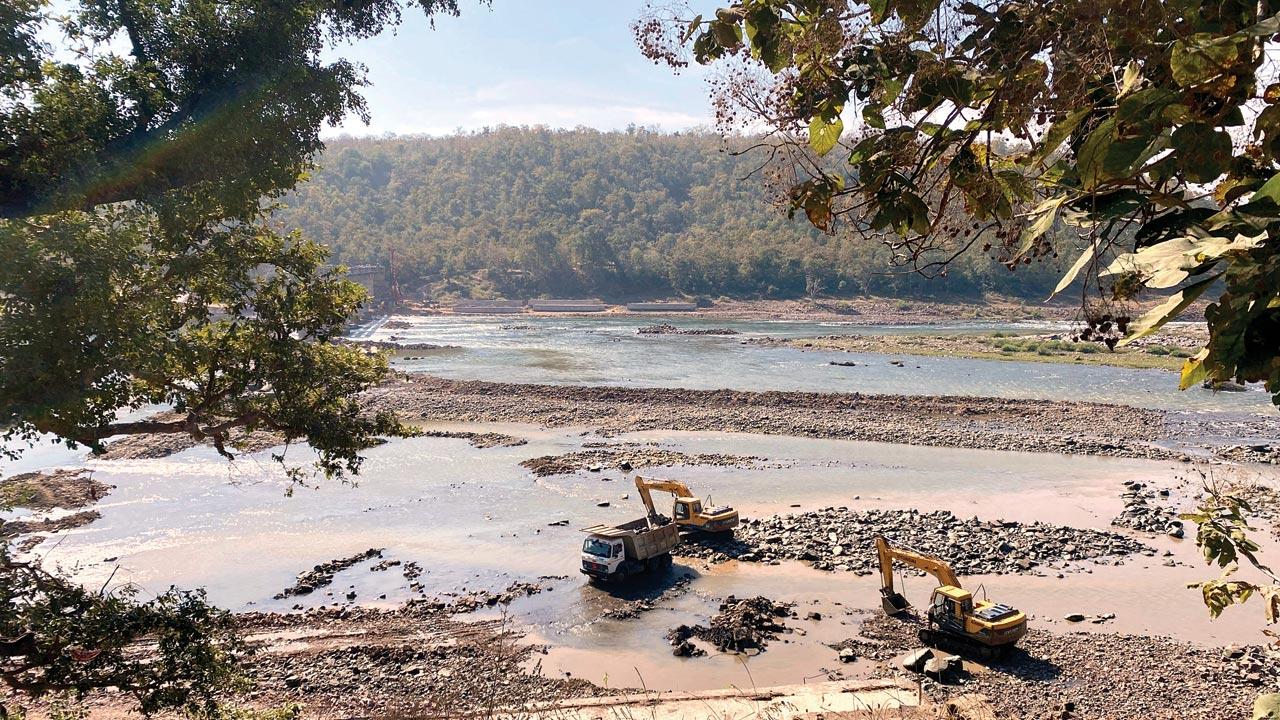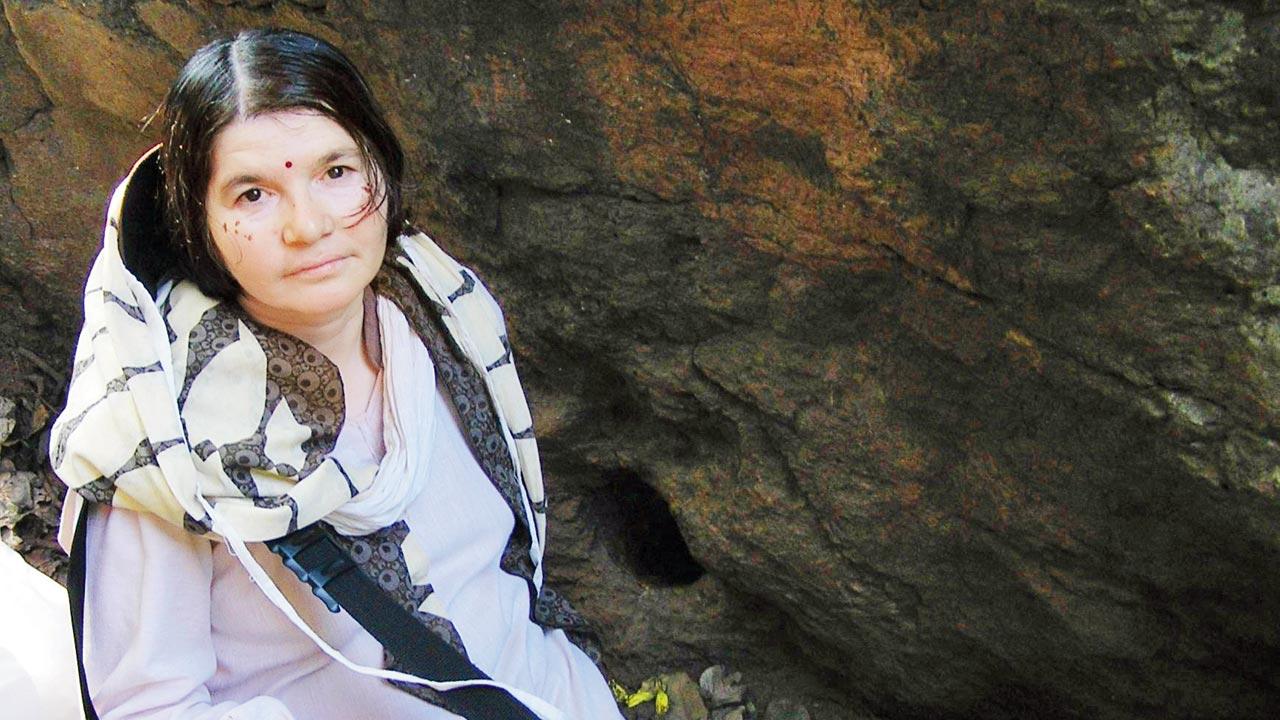The author of a bestselling book, which popularised the Narmada Parikrama as an act of spiritual overhaul, worries about pollution generated by the river’s devotees

Parikramawasis seen circumambulating the Narmada river afoot
![]() Bestselling authors look back at their creations with pride and joy. But, Bharati Thakur is an exception to the rule. Her much-feted Narmada Parikrama: Ek Antaryatra, launched now as an audio book, is referenced as a key travelogue for anyone circumambulating the Narmada river afoot. The 2009 book was prescribed as part of the graduate syllabus in SNDT Women’s University of Mumbai. It was a finalist entry in British Council’s (London) International Young Entrepreneur Publisher Award. While its Hindi translation is much appreciated, the English rendition is due this year. The book has won literary and social recognition; the author has just been conferred the Madhya Pradesh government’s Nanaji Deshmukh award.
Bestselling authors look back at their creations with pride and joy. But, Bharati Thakur is an exception to the rule. Her much-feted Narmada Parikrama: Ek Antaryatra, launched now as an audio book, is referenced as a key travelogue for anyone circumambulating the Narmada river afoot. The 2009 book was prescribed as part of the graduate syllabus in SNDT Women’s University of Mumbai. It was a finalist entry in British Council’s (London) International Young Entrepreneur Publisher Award. While its Hindi translation is much appreciated, the English rendition is due this year. The book has won literary and social recognition; the author has just been conferred the Madhya Pradesh government’s Nanaji Deshmukh award.
Thakur, 64, however, is not happy when the exodus of parikramawasis, particularly from Maharashtra, in the past decade, is credited to the popularity of her book, currently in the 12th print run. She feels Narmada Maiyya’s devotees need not crowd her banks “for the sake of pompous claims”. She refers to the scores of YouTube videos floating in the cyberworld in which parikramawasis have claimed miraculous darshan of Mata Narmada and Ashwaththama.
ADVERTISEMENT
 Narmada River, also known as Reva (bearing significance to the rich sand it holds), will lose its name, if the river sand is excessively mined for infra projects
Narmada River, also known as Reva (bearing significance to the rich sand it holds), will lose its name, if the river sand is excessively mined for infra projects
Thakur is soon to publish her new book, based on her post-Parikrama life devoted to underprivileged tribal children of remote Madhya Pradesh. The new memoir asks parikramawasis to be more sensitive to the ecosystem, especially the river water—it originates in MP, flows through Maharashtra and Gujarat before joining the Arabian Sea—that is fast losing its potability. This columnist met Thakur in the Narmadalaya precinct, where she is giving finishing touches to the new diary-inspired account.
“The river ghats are not for bathing and washing clothes, least for sewage disposal. By keeping the river to the right, the parikramawasi should walk parallel to the shore. The idea is to disconnect and detox the body and mind from everyday vyavahaar,” she says. Thakur is against the devotees’ constant mobile phone usage, which has upturned the significance of the parikrama in Instagram times. She feels the river circuit offers precious space in which the pilgrims, ideally so, meet themselves; it is not a mass gathering or a post-lockdown wilderness outing. “I blame writers like me who have written so emotionally about the river, that the parikrama seems like child’s play. It is not so, it is not meant to be so. There is a degree of physical mobility-adjustability and shramdaan integral to the walk.”
 Thakur, who did her 3,200 km-long parikrama between October 2005 and March 2006, says she saw it as an opportunity to connect with remote rural India situated on the banks of the rich river
Thakur, who did her 3,200 km-long parikrama between October 2005 and March 2006, says she saw it as an opportunity to connect with remote rural India situated on the banks of the rich river
For Nasik-based Thakur, an avid traveller-cyclist-mountaineer, who once had a secure government job, the parikrama was an exploration of an ancient mystic river; it was a soul-searching exercise conducted by three pals—Thakur, journalist Nivedita Khandekar and radio veteran-ace mountaineer Ushaprabha Page. The trio, essentially leading urban lives, looked upon the walk—October 2005 to March 2006—as an opportunity to connect with remote rural India situated on the banks of a rich river. “Adventure was not on our minds, but we wanted an intimate connection with an expansive sublime green zone. We wanted to soak in the serenity, which is why we walked without chatter.” Thakur adds that the “quiet” is at the root of the parikrama, which is fast losing its marvel in recent years. The nocturnal silence near the river is unparalleled; falling of dew drops can also be heard in the night hours.
Interestingly, Thakur has been travelling all over India as a speaker to share her parikrama experience and her resultant decision to settle in one of the villages, Lepa Punarvas, to work towards the education of children—predominantly living in the remotest Shoolpani jungle—who do not have access to municipal schools. In all her speeches, online interactions as well, she warns guests not to ask her stock questions like: Did Narmada Maiyya give you a heavenly darshan during the five-month parikrama? “Invariably, someone in the audience harps on the darshan,” she laughs.
In fact, Thakur is among the select experts/advisors that the Madhya Pradesh government recently approached in the context of channelising the parikramawasis in the state. In the last five years, visitors undertook various types of Narmada parikramas—Jalehari, Mundamal, Dandavat or even Vaahan-Car parikrama—due to which the government, particularly the MP Tourism Development Corporation, is deliberating on ways to tap religious tourists and clientele. The government at present doesn’t have an accurate figure of parikramawasis, as state borders aren’t equipped to track pilgrims’ itineraries. Veterans like Thakur are being sought for their perspective on retaining the discipline, sanctity and organic flow of the parikrama.
Some of Thakur’s suggestions, however, are indeed radical and rather unpopular. To begin with, she advises the parikramawasis to do away with the costly religious sankalp pooja in which the pilgrim (even those below the poverty line) pays a varying sum to the priest. Thakur asks why can’t a sankalp (resolution) be a personal inner-driven affair? Similarly, the kanyabhoj at Amarkantak is a pooja involving girls of pre-puberty age. Young village girls, treated to abundant food, turn obese and drop out from schools. She feels devotees can’t play with human lives in the name of Mata Narmada rituals. She also objects to the “culture of begging” perpetrated by parikramawasis. “Very rarely did the locals ask for money when we walked around the river. But nowadays children and women beg, rather brazenly.”
With the increasing number of devotees, villagers in the Narmada vicinity host several annachhatra (food shelters). Food is offered liberally to the parikramawasis who walk through village settlements or main highways; Thakur is very sensitive to the food wasted by the devotees. Often, at short notice, tour groups from Maharashtra visit her at the Narmadalaya residential school at Lepa; they demand specific food on fasting days. “If they are treated to meals of their choice at a particular village, they don’t bother to inform us about their change of route.” Thakur has suggested that the MP government initiate budget homestays for the devotees on the parikrama route. That will streamline two aspects: first, it will discipline the food management at individual villages, second, it will create better toilet/sanitation avenues for the visitors. “Villagers need employment in the post-lockdown scenario. If they are allowed to host pilgrims at a decided rate, they will be enthused to maintain clean facilities. There will be a watch on households/hotels, which shamelessly pump the sewage pipes into the Narmada; also on parikramawasis who defecate in open areas.”
The author feels the state government needs to hasten up its Narmada Bachao initiatives, because the pandemic-impacted world has brought new layers of complications in the Narmada parikrama. “The parikrama has become a getaway for the jobless, it is a solace for the lonely-isolated city dwellers; it is a haven for those consuming opium; it is a deposit box of senior citizens who are shooed away by their children,” laments Thakur. Once she rescued an 86-year old aaji who fell ill during the parikrama. As the matriarch felt better, she requested Thakur not to transport her back to Pune; the family didn’t expect an early return.
Thakur feels Narmada parikrama is a soul-satisfying walk. In today’s times of ecological imbalance, it cannot be allowed to continue in its current irresponsible touristic avatar. In fact, the danger to the river, especially in the form the sand mining, is alarming. “If visitors can’t become river protectors, they can at least not pollute the ecosystem with biscuit wrappers.” Also if pilgrims throw seeds of seasonal fruits along the parikrama, she feels that the upcoming generations will also have a resplendent river route to follow.
Sumedha Raikar-Mhatre is a culture columnist in search of the sub-text. You can reach her at sumedha.raikar @mid-day.com
 Subscribe today by clicking the link and stay updated with the latest news!" Click here!
Subscribe today by clicking the link and stay updated with the latest news!" Click here!








